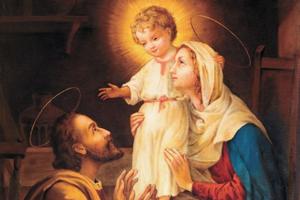After Lourdes, St. Bernadette Hid in the Shadow of St. Joseph
‘There were two important periods in Bernadette’s life,’ says André Doze. ‘The phase of Lourdes, which was mostly under the sign of Mary, and the phase of Nevers, under the sign of Joseph.’

On Feb. 14, 1858, following her second apparition conversing and praying with the Blessed Virgin Mary at the grotto of Massabielle in Lourdes, France, Bernadette Soubirous sat on a chair in the Savy Mill, weeping for joy as she recovered from her rapturous encounter with the beautiful, unknown visitor whom she called “The Lady.” Townsfolk who had accompanied her stood nearby, perplexed yet eager to hear about her experience and to learn the true identity of the visitor. Could it be the Blessed Virgin Mary?
These same sentiments, however, were not shared by Bernadette’s mother, Louise. According to Abbé François Trochu, in his book, Saint Bernadette Soubirous, upon hearing the news that her oldest child had once again returned to the grotto against her wishes, Louise soon bolted through the door, a rod of discipline in hand, and shouted, “You little scamp! What do you mean, making everyone run after you?”
Bernadette was calm and replied in a soft tone, “But, Mama, I never told anyone to follow me.” Realizing God’s favor was upon her child, Louise, relenting, broke down and cried.
Bernadette, illiterate and stunted in growth from chronic asthma and bouts of cholera, had suddenly become Mary’s messenger for the world. She eschewed fame, ignored doubters and spoke Mary’s succinct messages with clarity to those that knocked on the door of the poor confines of the Soubirous’ one-room abandoned prison during the day and asked for prayers. She welcomed thousands that followed her to the grotto, and repeated Mary’s pleas to all: “Pray; do penance!”
During interrogations, she never veered from the original details of the apparitions, and remained undaunted before priests and prelates who scoffed when she told them the Lady’s message to organize processions and to build a chapel. Finally, on March 25, the feast of the Annunciation, upon learning from the Lady her name, Bernadette ran back up the hill from the grotto, breathless as she repeated over and over the words she had never heard before nor knew the meaning of, and announced them to her parish priest, telling him, “She said, ‘I am the Immaculate Conception.’” A marvel! An ignorant young peasant had just confirmed the dogma of the Immaculate Conception, decreed four years previously by Pope Pius IX.
With that, Bernadette’s mission was complete. Mary continued to guide her, leading her to be educated at the boarding house in Lourdes, and then to her vocation as a religious in Nevers. But in a new way, Mary turned Bernadette’s inner gaze toward St. Joseph, the master of silence and prayer. As I see it, the inspiration was imparted to Bernadette during the final apparition of July 16, when Mary appeared as Our Lady of Mount Carmel but without speaking. Silent. As André Doze explained in his book, St. Joseph in the Life of St. Bernadette of Lourdes, “There were two important periods in Bernadette’s life, the phase of Lourdes, which was mostly under the sign of Mary, and the phase of Nevers, under the sign of Joseph.” (Centre de recherche et de documentation Oratoire Saint-Joseph Montreal, 1998)
According to Doze, St. Joseph was Bernadette’s protector under whose shadow she hid. As she intimated to a sister on the day of her first profession of vows, “I have come here to hide myself.” During the apparitions, it became known that Mary shared secrets with Bernadette, the matters of which she was told never to reveal. Who better than St. Joseph, then, for Bernadette to entrust herself to as she continued to be visited, often by the unscrupulous determined to trap her in speech and become the first to unveil her secrets? For as Doze explained, St. Joseph alone was able to accomplish the “impossible task” of concealing Mary, the Virgin Mother, and Jesus, the Son of God, from the knowledge of the scholars of the law, the elders and the so-called experts on the coming of the Messiah. St. Joseph alone was able to conceal the miraculous events before and after the birth of Jesus from the angelic intelligence of Satan, and to save Jesus from the massacre of Herod. At the angel’s word to him within the privacy of a dream — how fitting! — Joseph carried his family to safety, and then back to their hidden life in Nazareth where Jesus grew in “wisdom, age and grace,” learning silence, unassuming righteousness, and attention to detail as he worked alongside his foster father, a humble workman. Later, such “provenance” would be flung in accusation against Jesus by the scribes and pharisees repelled by ordinariness and threatened by his authority. Infuriated, they sneered, “Is this not the carpenter’s son?” (Matthew 13:55).
It was according to the hidden life of Nazareth and especially St. Joseph that Bernadette lived for the rest of her life and confirmed her intent by detaching herself henceforth from all the matters of Lourdes. She wrote in the opening lines of her notebook in 1871, “What concerns me no longer concerns me. I must be, from now on, entirely to God and only to God. Never for myself.”
She spoke little about her devotion to St. Joseph, but her community caught glimpses of it from time to time, as one sister testified:
One day, Bernadette was praying to the Virgin Mary for me, but I noticed she was kneeling before the statue of Saint Joseph. When I pointed this out to her, she replied, ‘In heaven, no one is jealous.’
Another time, a young novice was struggling to meditate during prayer and asked Bernadette’s advice, who said simply, “Say, St. Joseph, teach me how to pray.” Admitting her own struggles, she added, “When we are unable to pray, we go and talk to St. Joseph.”
Bernadette’s devotion took a new turn following the death of her father, François, whose loss she felt deeply. From then on, she was often seen walking toward the chapel of St. Joseph in the garden. The chapel was her favorite to pray in. “Be good now,” she told a sick sister one day, humoring her with typical cheerfulness as she finished her caregiving work in the infirmary and prepared to leave. “I am going to pay my father a visit now.” Seeing a look of bewilderment on the sister’s face at the reference to her father, however, Bernadette quietly reminded her, “Don’t you know that my father is now St. Joseph?"
This paternity of St. Joseph in Bernadette’s life, explained Doze, would never become more evident than at the moment of her death in 1879. For several months preceding, she had suffered excruciating pain from an open tumor on her knee. Now, in desperate need of patience and strength, on March 19, the feast of St. Joseph, she begged him for the grace of a holy death. Her prayer was answered the following month on April 16 when, summoning her last breath of energy, she twice prayed, “Holy Mary, Mother of God, pray for me, a poor sinner,” then closed her eyes and died in perfect peace.
This year, the celebration of Bernadette’s feast day, April 16, was superseded by Holy Saturday, the day of liturgical silence when the Church commemorates the entombment of Jesus. I find it a lovely reflection to notice a likeness between the entombment of Jesus and that of Bernadette. For just as the body of Jesus was anointed and laid to rest in a new tomb in the garden, so also did the body of Bernadette become the first in the community to be laid to rest in the little chapel in the garden she loved so much — the chapel dedicated to St. Joseph.
- Keywords:
- st. joseph
- st. bernadette
















